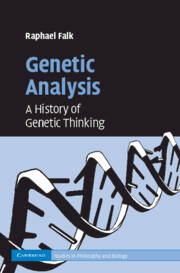Book contents
- Frontmatter
- Contents
- List of figures
- Acknowledgments
- Introduction
- PART I FROM REPRODUCTION AND GENERATION TO HEREDITY
- PART II FAKTOREN IN SEARCH OF MEANING
- PART III THE CHROMOSOME THEORY OF INHERITANCE
- PART IV GENES AS THE ATOMS OF HEREDITY
- PART V INCREASING RESOLVING POWER
- 11 Recruiting bacteria and their viruses
- 12 Molecular “cytogenetics”
- 13 Recombination molecularized
- PART VI DEDUCING GENES FROM TRAITS, INDUCING TRAITS FROM GENES
- PART VII WHAT IS TRUE FOR E. COLI IS NOT TRUE FOR THE ELEPHANT
- Concluding comments
- Bibliography
- Index
11 - Recruiting bacteria and their viruses
Published online by Cambridge University Press: 07 August 2009
- Frontmatter
- Contents
- List of figures
- Acknowledgments
- Introduction
- PART I FROM REPRODUCTION AND GENERATION TO HEREDITY
- PART II FAKTOREN IN SEARCH OF MEANING
- PART III THE CHROMOSOME THEORY OF INHERITANCE
- PART IV GENES AS THE ATOMS OF HEREDITY
- PART V INCREASING RESOLVING POWER
- 11 Recruiting bacteria and their viruses
- 12 Molecular “cytogenetics”
- 13 Recombination molecularized
- PART VI DEDUCING GENES FROM TRAITS, INDUCING TRAITS FROM GENES
- PART VII WHAT IS TRUE FOR E. COLI IS NOT TRUE FOR THE ELEPHANT
- Concluding comments
- Bibliography
- Index
Summary
The application of biochemical processes as phenotypic markers of Mendelian factors is not new. As early as 1901 the physician Archibald Garrod cooperated with Bateson in collecting “extraordinarily interesting evidence … regarding the condition known as ‘Alkaptonuria’” (Bateson and Saunders, 1902, 133–134). Alkaptonuria was one of several diseases that appeared to be markers of Mendelian factors and were later called by Garrod “inborn errors of metabolism” (Garrod, 1908). Systematic studies of markers of inherent biochemical variability were carried out by J. B. S. Haldane and his associates on the synthesis of anthocyanins that are involved in flower color in various plant species, such as Pelargonium (Haldane, 1954, 52–58). Also in Drosophila notions of the biochemical basis of genetic differences were investigated in studies such as that by Sturtevant (1929) on the eye-color mutant vermilion.
Although many investigators conceived of the role of genes in developmental and biochemical terms, Boris Ephrussi and George Beadle made a breakthrough when they applied the classical methods of developmental mechanics to problems of genetic analysis in Drosophila (Beadle and Ephrussi, 1936). They transplanted the imaginal discs of the eyes from larvae of one genotype into larvae of another type, which enabled them to inspect the transplant's eye color in the host-imago's abdomen. The autonomy or non-autonomy of the transplant's eye color provided an indication of the function of specific genes in the developmental pathways of eye-color pigmentation. Demonstrating the feasibility of that analytic approach, the problem was obviously more biochemical than developmental.
- Type
- Chapter
- Information
- Genetic AnalysisA History of Genetic Thinking, pp. 178 - 190Publisher: Cambridge University PressPrint publication year: 2009



